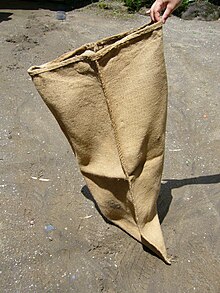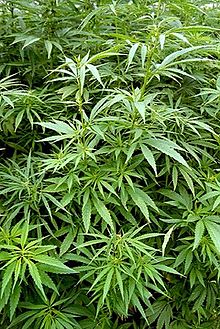Hemp textile
As hempbag all textiles are called, from hemp fibers are made. In addition to clothing textiles, this also includes home textiles and technical textiles such as geo and agricultural textiles . After hemp paper and hemp pulp, hemp textiles are the most important product made from hemp fibers.
Areas of application
For the historical use of hemp fibers in general, see main articles hemp fiber and industrial hemp
The oldest finds on the use of hemp fibers for the production of textiles come from China around 2800 BC. BC, where ropes were made from hemp fibers. The plant has been used since the Yangshao culture in the 4th millennium BC. Since about 900 BC In BC hemp also found widespread use in West Asia and India. The oldest textile fragment made of hemp fibers comes from a grave of the Zhou dynasty (1122–770 BC), near Ankara , hemp textiles from the 8th century BC were found. Found. Around 500 BC Hemp cultivation for the area between China and the Caspian Sea can be assumed. In Europe, the manufacture of hemp textiles was also proven by grave finds; Here the oldest woven fragment comes from a Celtic burial mound near Stuttgart from a time around 500 BC. BC and another with processed hemp fibers from around the year 570 was found near Paris. Until the 3rd century BC Hemp found its way to Italy, especially in the form of ropes and similar products.
Clothing and home textiles
Hemp has always been used very often, especially for the manufacture of clothing. Up until the 19th century, hemp fibers were the most important raw materials for the European textile industry, alongside flax , nettle and wool , with hemp mainly used in the manufacture of outerwear and workwear due to the coarser fiber bundles. Hemp processing played a key role in textile processing before the introduction of cotton and other exotic fibers such as jute , sisal and ramie . With the increasing use of cotton as a clothing material, however, the use of hemp and other natural fibers fell sharply; only wool was able to assert itself. Above all, the development of cotton spinning machines in the 19th century and the cheap imports of cotton and jute, especially from Russia and Asia, ended the use of hemp and flax as textile fibers.
In the middle of the 20th century, hemp textiles had become rare on the market in industrialized countries; they were only rediscovered in the 1990s. Even today, hemp clothing is only a niche product, although a process was developed through so-called cotonization that gives hemp fibers similar properties to cotton. Hemp long fibers come mainly from China and are used almost exclusively in the production of textiles. They are very tear-resistant and are particularly suitable for the clothing industry. Clothing made from hemp also has the ability to absorb around 30% moisture and is therefore very comfortable to wear.
Technical Textiles
In the late Middle Ages , hemp was the most important industrial plant alongside flax . Because of its great tensile strength, it was mainly used to make sailcloth, ropes and sacks, but because of its coarseness, it was rarely made into cloth. Hemp fibers reached their peak in use in the 17th century, when they were mainly used for the production of ropes and sailcloth for shipping; for a normal sailing ship around 50 to 100 tons of hemp fiber were required and the materials were replaced on average every two years. In the 19th century, the need in shipping decreased, as many ships were converted to steam power and canvas was no longer needed.
Until the middle of the 20th century, hemp cultivation was greatly reduced internationally, in part through bans on the use of cannabis as an intoxicant . Hemp was primarily used for the pulp industry, which still uses most of the hemp fiber today. Technical textiles made from hemp fibers have gained increasing importance in recent years, especially in the form of felts and nonwovens , which are used as natural insulation and in the production of natural fiber-reinforced plastics . A successful niche product are agricultural textiles in the form of cultivated nonwovens for garden cress , in which hemp fibers are used. Geotextiles such as Quickly rotting greening mats made from hemp fibers are also possible, but have not yet been used due to the higher costs compared to other natural fibers such as coconut fibers .
Individual evidence
- Jump up ↑ on the early days see Jürgen Schultze-Motel: Hanf , In: Lexikon alten Kulturen Vol. 1 (1984), p. 344
- ↑ on antiquity see Christian Hünemörder : Hanf , In: Der Neue Pauly Bd. 5 (1998), Sp. 151f.
- ^ W. Hingst, H. Mackwitz: Reiz-lingerie. Our clothes: fashion, poisons, eco-look. Campus-Verlag, Frankfurt 1996
- ↑ on the Middle Ages see Christian Reinicke: Hanf , In: Lexikon des Mittelalters Bd. 4 (1999), Sp. 1918f.
literature
- Ivan Bócsa, Michael Karus, Daike Lohmeyer: The hemp cultivation. Botany, varieties, cultivation and harvest, markets and product lines. 2nd edition, Landwirtschaftsverlag GmbH, Münster 2000.
- Michael Carus et al .: Study on the market and competitive situation for natural fibers and natural fiber materials (Germany and EU). Gülzower Expert Discussions 26, ed. from the Agency for Renewable Raw Materials eV, Gülzow 2008 Download (PDF; 3.9 MB).
- Klaus-Ulrich Heyland, Herbert Hanus, Ernst Robert Keller: Oil fruits, fiber plants, medicinal plants and special crops. Handbook of Crop Production Volume 4. Eugen Ulmer KG, Stuttgart 2006; Pages 290-307, ISBN 978-3-8001-3203-4 .
- nova-Institut (Ed.): Das kleine Hanf-Lexikon. Verlag Die Werkstatt, Göttingen, 2nd edition, 2003; Pages 63-64. ISBN 3-89533-271-2
- Robert R. Franck (Ed.): Bast and other plant fibers. Woodhead Publishing Limited, Cambridge 2005.


